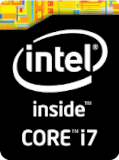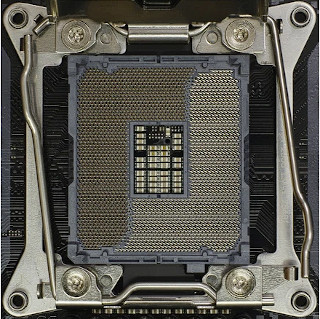8
Cores
16
Threads
140 W
TDP
3 GHz
Frequency
3.5 GHz
Boost
Haswell-E
Codename
Socket 2011-3
Socket
The Intel Core i7-5960X was a desktop processor with 8 cores, launched in September 2014. It is part of the Core i7 Extreme lineup, using the Haswell-E architecture with Socket 2011-3. Thanks to Intel Hyper-Threading the core-count is effectively doubled, to 16 threads. Core i7-5960X has 20 MB of L3 cache and operates at 3 GHz by default, but can boost up to 3.5 GHz, depending on the workload. Intel is building the Core i7-5960X on a 22 nm production process using 2,600 million transistors. You may freely adjust the unlocked multiplier on Core i7-5960X, which simplifies overclocking greatly, as you can easily dial in any overclocking frequency.
With a TDP of 140 W, the Core i7-5960X consumes a lot of power, so good cooling is definitely needed. Intel's processor supports DDR4 memory with a quad-channel interface. The highest officially supported memory speed is 2133 MT/s, but with overclocking (and the right memory modules) you can go even higher. For communication with other components in the system, Core i7-5960X uses a PCI-Express Gen 3 connection. This processor does not have integrated graphics, you will need a separate graphics card.
Hardware virtualization is available on the Core i7-5960X, which greatly improves virtual machine performance. Additionally, IOMMU virtualization (PCI passthrough) is supported, so that guest virtual machines may directly use host hardware. Programs using Advanced Vector Extensions (AVX) will run on this processor, boosting performance for calculation-heavy applications. Besides AVX, Intel is including the newer AVX2 standard, too, but not AVX-512.
With a TDP of 140 W, the Core i7-5960X consumes a lot of power, so good cooling is definitely needed. Intel's processor supports DDR4 memory with a quad-channel interface. The highest officially supported memory speed is 2133 MT/s, but with overclocking (and the right memory modules) you can go even higher. For communication with other components in the system, Core i7-5960X uses a PCI-Express Gen 3 connection. This processor does not have integrated graphics, you will need a separate graphics card.
Hardware virtualization is available on the Core i7-5960X, which greatly improves virtual machine performance. Additionally, IOMMU virtualization (PCI passthrough) is supported, so that guest virtual machines may directly use host hardware. Programs using Advanced Vector Extensions (AVX) will run on this processor, boosting performance for calculation-heavy applications. Besides AVX, Intel is including the newer AVX2 standard, too, but not AVX-512.
Physical
| Socket: | Intel Socket 2011-3 |
|---|---|
| Foundry: | Intel |
| Process Size: | 22 nm |
| Transistors: | 2,600 million |
| Die Size: | 356 mm² |
| Package: |
Processor
| Market: | Desktop |
|---|---|
| Production Status: | End-of-life |
| Release Date: | Sep 1st, 2014 |
| Part#: | SR20Q |
Performance
| Frequency: | 3 GHz |
|---|---|
| Turbo Clock: | up to 3.5 GHz |
| Base Clock: | 100 MHz |
| Multiplier: | 30.0x |
| Multiplier Unlocked: | Yes |
| TDP: | 140 W |
Architecture
| Codename: | Haswell-E |
|---|---|
| Generation: |
Core i7 Extreme
(Haswell-E) |
| Memory Support: | DDR4 |
| Rated Speed: | 2133 MT/s |
| Memory Bus: | Quad-channel |
| ECC Memory: | No |
| PCI-Express: |
Gen 3, 40 Lanes (CPU only) |
| Chipset: | X99 |
Core Config
| # of Cores: | 8 |
|---|---|
| # of Threads: | 16 |
| SMP # CPUs: | 1 |
| Integrated Graphics: | N/A |
Cache
| Cache L1: | 64 KB (per core) |
|---|---|
| Cache L2: | 256 KB (per core) |
| Cache L3: | 20 MB (shared) |
Features
|
Apr 26th, 2024 18:43 EDT
change timezone
Latest GPU Drivers
New Forum Posts
- Best SSD for system drive (101)
- What phone you use as your daily driver? And, a discussion of them. (1492)
- AMD Radeon™ R9 390X (GV-R939XG1) (0)
- TPU's Nostalgic Hardware Club (18475)
- looking to build a new system and im considering asrock brand but i have some doubts/concerns. (6)
- What's your latest tech purchase? (20354)
- 5800x (and other Zen 3 chips) PBO settings/Temperature fix (934)
- Only EDP Other in Core? (2)
- Alphacool CORE 1 CPU block - bulging with danger of splitting? (30)
- Dell Workstation Owners Club (3061)
Popular Reviews
- HYTE THICC Q60 240 mm AIO Review
- MOONDROP x Crinacle DUSK In-Ear Monitors Review - The Last 5%
- Upcoming Hardware Launches 2023 (Updated Feb 2024)
- Alienware Pro Wireless Gaming Keyboard Review
- Thermalright Phantom Spirit 120 EVO Review
- Ugreen NASync DXP4800 Plus Review
- FiiO K19 Desktop DAC/Headphone Amplifier Review
- ASUS Radeon RX 7900 GRE TUF OC Review
- AMD Ryzen 7 7800X3D Review - The Best Gaming CPU
- Sapphire Radeon RX 7900 GRE Pulse Review
Controversial News Posts
- Windows 11 Now Officially Adware as Microsoft Embeds Ads in the Start Menu (135)
- Sony PlayStation 5 Pro Specifications Confirmed, Console Arrives Before Holidays (117)
- NVIDIA Points Intel Raptor Lake CPU Users to Get Help from Intel Amid System Instability Issues (106)
- AMD "Strix Halo" Zen 5 Mobile Processor Pictured: Chiplet-based, Uses 256-bit LPDDR5X (103)
- US Government Wants Nuclear Plants to Offload AI Data Center Expansion (98)
- AMD's RDNA 4 GPUs Could Stick with 18 Gbps GDDR6 Memory (95)
- Developers of Outpost Infinity Siege Recommend Underclocking i9-13900K and i9-14900K for Stability on Machines with RTX 4090 (85)
- Windows 10 Security Updates to Cost $61 After 2025, $427 by 2028 (84)


